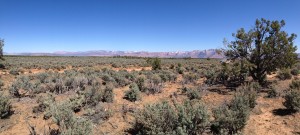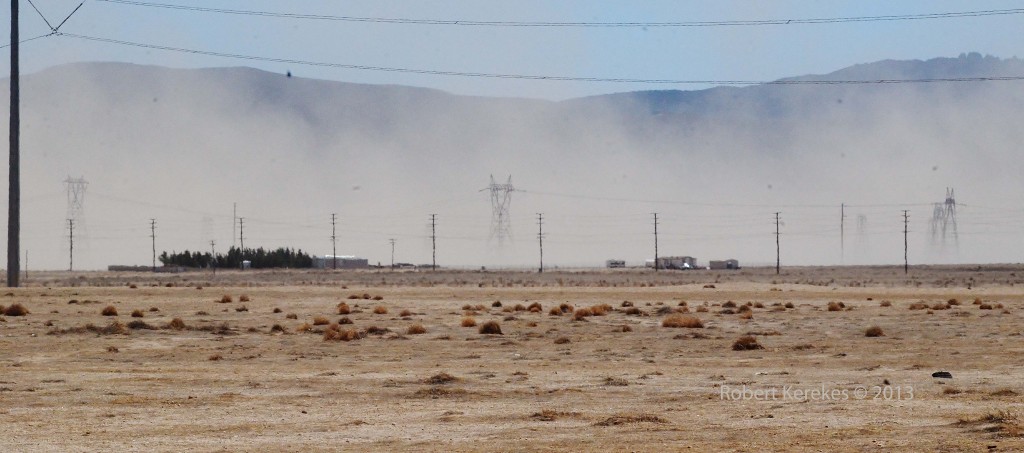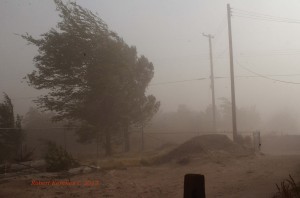BACKGROUND:
During the 2014 March through May windy season, fugitive dust in the Western Antelope Valley (located in northern Los Angeles County and the southeast portion of Kern County, California) negatively impacted air quality to an extent never experienced before. It has been likened to the Great Dust Bowl of the 1930‘s.
The historic drought of the past six years is generally acknowledged as precipitating the clouds of sand, which become airborne with the strong dry winds blowing in the afternoon and evening. However, the much hoped-for end to the drought (if we do indeed get El Nino conditions this winter) will not solve the Mojave* Dust Bowl problem.
The sources of this dust are complex: Large scale solar and wind power facilities, and Southern California Edison’s grid line and power station infrastructure are the current suspected causes of the problem. However, anyone who delves into the history of this high desert land soon realizes that the combination of barren or abandoned farm land is also a major contributing culprit. Solar farms, power corridors and urban development have undoubtedly contributed to dust emanating from large tracts of disturbed lands during construction activities, but similarly vulnerable bare agricultural lands (land being tilled; fallow fields; post-harvest fields) are in all likelihood the greatest contributor to poor air quality.

Solar power development prior to re-establishment of sustainable native plant growth for long-term soil stabilization.
In addition to on-going large-scale cropping activities, historic disturbances included the introduction of exotic grasses for cattle grazing in place of native plant species over extensive tracts of desert lands, which has made these lands especially susceptible to wind erosion during drought conditions.
THE PROBLEM:
Problems created by fugitive dust include:
- soil erosion, especially topsoil loss;
- dune formation, including the burial of buildings, fences etc.;
- poor visibility, periodically contributing to fatal automobile accidents;
- human health issues caused by PM10 particulates (less than 10 microns in diameter) have an ability to penetrate deep into the lungs and blood streams;
- Valley fever has been increasing, a disease caused by a fungus that can be deadly for humans whose natural immune system is weak.
Despite attempts to draw attention to their plight, local residents are frustrated by a lackluster response by their regulatory bodies. The County’s energies are focused on the ongoing building of renewable energy facilities. Seemingly little attention is being paid to the consequences of such development that is destroying the environmental well-being of their community.
Regulatory decisions impacting the environment are being made by personnel who are not well grounded in leading edge reclamation technologies, or who do not clearly understand the complexity of addressing the problem. For example, permit specifications demanding that disturbed lands in the Mojave Desert attain 70% coverage with native plant species within two years is unrealistic. This lack of regulatory expertise often results in decisions not being made at all, thereby causing expensive project delays.

Native plant growth in a “high desert” climate. One can’t destroy what took 5,000 years to create and expect to rectify the damage within a 2-year time frame.
By the same token, developers of construction projects that disturb broad expanses of desert landscape could also benefit from state-of-the-art reclamation technologies. All too often more ground is being disturbed than absolutely needs to be disturbed (Los Angeles County has recently banned clear-grading in the course of constructing solar facilities). Once that disturbance has occurred, we constantly observe outdated tried-and-failed revegetation practices being implemented that have little-to-zero chance of producing sustainable stabilization results. The cost of repeated attempts at stabilizing soil can mount up quickly when outdated and ineffective approaches are being used.
Conventional soil stabilization practices do not even begin to address what we know to be the underlying key challenge to soil stabilization: sustainable native plant growth achieved by re-establishing a functioning soil community in that soil zone where live topsoil once existed.
The Quattro Alliance Solution:
Quattro Environmental and the Quattro Alliance team of professionals have the technologies to mitigate the Mojave Dust Bowl problem. We have demonstrated this repeatedly over 20 years in challenging environments spanning Wyoming, Montana, Idaho, Eastern Washington and Eastern Oregon, down through Nevada and south into the Mojave and Sonoran deserts of California and Arizona.
The drought is a convenient scapegoat for the extreme levels of fugitive dust currently blanketing the Antelope Valley whenever the afternoon winds blow. However, even if the much-hoped for El Nino phenomenon arrives later this year, the above-average rains will not bring sustainable relief to the fugitive dust problems of the “high desert” regions — unless a readily available technology such as Quattro’s Living Soil Membrane® (“LSM”) is brought to bear.
This LSM® technology addresses both the immediate “Holding Soil” challenges of the specific project, as well as the “Growing Soil” challenges to successfully re-establish sustainable native plant growth for long-term soil stabilization. Nurturing early seral stage plant species in tandem with mineral balancing + biological amendments sets the stage for the natural, accelerated re-establishment of a functioning, site-specific soil biological community. Conversely, absent the revival of such a functioning soil biological community (as is the case with conventional reclamation practices), hardy native plant species have little chance of survival.
Utilizing Quattro’s “Holding Soil” technologies NOW to immediately stabilize soil while the “Growing Soil” protocol works on the underlying (literally) factors of healthy native plant ecology will ultimately produce a viable, long-term and enduring solution to the Mojave Dust Bowl problem. By doing so, developers and agency personnel will be able to take advantage of the El Nino rains expected as early as fall 2014.
Footnote*: The Mojave Desert in California (within which the Antelope Valley is located), at elevations of 2,000 to 5,000 feet, is a transition desert between the hot Sonoran Desert to the south, and the cooler Great Basin Desert to the north. The climate has extreme fluctuations of daily temperatures (as low as 8°F in January and as high as 119°F in August). Although it is windy during all months, in late winter and early spring winds in excess of 25 mph with gusts of 75 mph or more are not uncommon.



